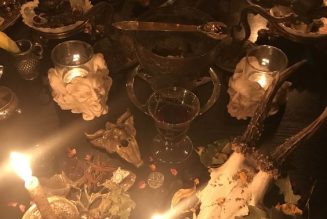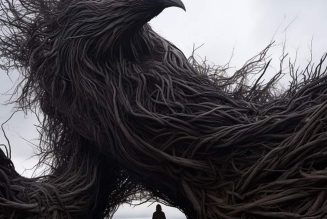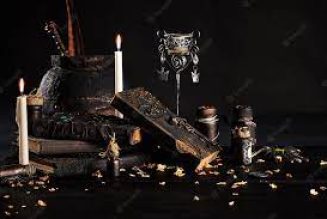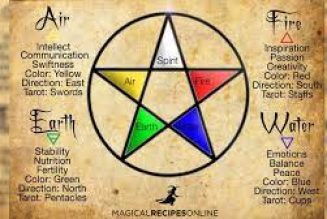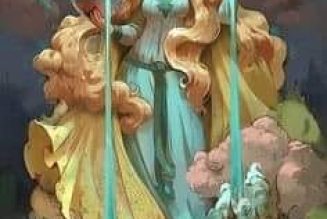
The year is 1586, the night is dark and mysterious, only a sliver of the moon hangs in the sky. The autumn wind is chilly, and it blows the leaves from the trees. Two witches, one an old woman with grey hair, and another, a young man half her age, meet in an old country lane. They quietly exchange greetings and then hurry towards a nearby cemetery in an old, abandoned churchyard, looking around them for signs they are being watched. The wind blows, the night is quiet except for the distant hoot of an owl.
When they arrive at the cemetery each one draws a few items from their pockets. The man brings forth a book, The Discoverie of Witchcraft, and from his sleeve, a wand made of hazel wood. The woman produces a crystal stone, and a candle. Together, they approach a fresh grave at the far edge of the cemetery.
When they arrive at the grave, the woman lights the candle, holding the crystal in her other hand. The air is thick with spirits and both witches feel a certain apprehension, a knowing that what they are doing is spiritually dangerous and could also get them executed by the secular authorities. They are risking their lives to carry out this work of magic.
The man takes the wand and gently strikes the dirt of the grave. “Arise, Arise,” he begins to call the ghost. He addresses the ghost by name, telling it to come forth and enter the crystal stone. He promises the ghost that if he will help the witches, and obey them, that he will do a good deed in the ghost’s name, and thus help them get to heaven. He tells the ghost that the witches need its help to go and get a fairy that they wish to conjure, the Fairy
Sibylia.
Dozens of spirits swirl around the two witches now. Some of them are relatives of the witches. “Stop this heresy!” one demands. “To invoke the dead is a great sin,” another ghost says. “You are going to hell,” another ghost warns. The two witches ignore these voices and carry on their work.
Lights seem to play around the edges of the stone, it glows. Spirits swirl around it, almost swimming in the air. “Could this be a home for us?” one asks. The ghost of a little child peeks around a headstone. The ghost of a witch who is buried in the graveyard looks on approvingly. The crystal stone is the center of the motion, it seems to attract the spirits to it.
The younger man continues to say the words of
conjuration from the book, commanding the ghost to appear in the stone. Then, the old woman says, “I see him, I see the ghost, he has taken the form of himself when he was young, look inside.” The younger man looks and sees, the stone is glowing many colors, orange, red, green, and purple. He reaches his hand out and touches the stone, it feels warm. The book says this is a sign that things are going well.
Somewhere deep inside the stone he can see the form of the ghost he had conjured, the one who had killed himself, an old friend of his. Success! Suddenly there is a moment of sadness, the memories the ghost had in his life, and his sorrows. “I will pray for you,” the male witch murmurs quietly, “I will do good deeds in your name.” “Work with me my friend and help me to find the fairy Sibylia.” The ghost agrees to the deal.
The two witches then close the book and then enter the abandoned church next to the cemetery. Taking chalk from their pockets, they quickly draw an ornate magic circle on the ground. It is fortified with divine names, and a Bible verse. The design is taken from the book. By this time, it is midnight.
As a final protection, the witches draw small leather shields from their pockets and pin them to their chests. Upon the shield looking coverings are the words Sorthie, Sorthia, Sorthios. All around the circle, candles are lit. A smaller circle is drawn with the chalk, outside the larger one, for the Fairy Sibylia to appear in.
The Hazel wand and crystal stone are once again drawn forth, the moon shines in from part of the roof which has caved in. Frankincense is produced from the pocket of the female witch and the smell wafts through the old, abandoned church.
Once again, the male witch conjures the spirit of the ghost, which has now entered the stone. It appears once again; the witches ask the ghost to go and get the fairy. It disappears from the stone, the room grows quiet, there is a moment of silence…
Then she arrives, the fairy. She is standing within the smaller circle outside the larger circle which the witches have drawn. She is indescribably beautiful with curly blond hair, elvish looking ears, and blue green eyes. She wears a long white dress which sparkles and silver armlets and rings and a tiara around her head of silver. She has wings of a butterfly with purple hues.
Beams of light emanate from her, and she holds a magic wand made of hazel wood, with the tip glowing a brilliant white. Her splendor lights up the dark candle lit room as if it were suddenly illuminated by the brightest moonlight. In and through this light, hundreds of smaller fairies’ dart
and fly at high speeds all around the magic circle and the witches.
The male witch quickly addresses the fairy using the names and words given in the book, asking her not to harm a hair on their heads, and to be kind to them. His companion takes the Frankincense and waves it towards her, asking the fairy to accept the incense as a gift, and to work with them as a friend and ally in the spiritual plane.
She agrees and then begins to instruct the witches in various ways to cast spells and improve their magic. She gives a couple of the smaller fairies to them as familiar spirits and tells them to watch over the witches. Finally, the male witch reads another conjuration from the book, which tells her that she may come and go as she pleases, and she promises to see them again for more teaching, and that someday she will even give them the power to go invisible.
Then in a flash, she is gone, and takes all the light from the room with her, and the little fairies as well. The two witches hurriedly gather their magical tools and return to their homes in silence, vowing to keep the secrets of their work from the church.
